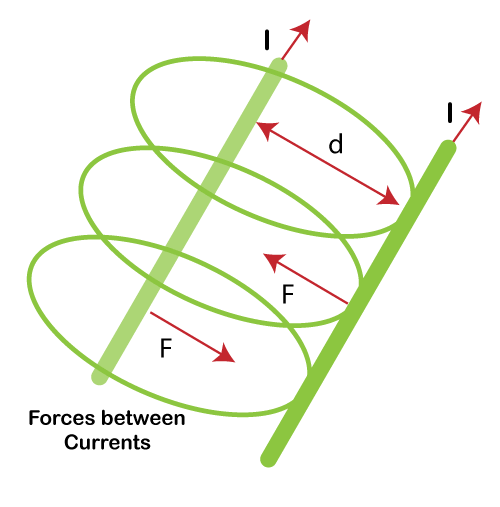Ampere's LawAmpere's law is a fundamental principle of electromagnetic that connects an electric current's magnetic field to the current itself. It was developed in the early nineteenth century by the French physicist Andr�-Marie Ampere and is one of four Maxwell's equations that describe the behaviour of electromagnetic fields. 
Ampere's law states that whenever there is a passage of electric current, a magnetic field is produced. This magnetic field is circular, and its strength is proportional to the current flowing through the wire. How to Find the Direction of the Magnetic Field?The magnetic field direction can be determined using the right-hand rule, which asserts that if the right hand's fingers are curled around the wire in the direction of the current, the thumb will point in the direction of the magnetic field lines. According to Ampere's rule, the line integral of the magnetic field surrounding any closed path is equal to the current enclosed by that path multiplied by a constant factor known as free space permeability. This can be stated mathematically as: B·dl = μ0Ienc Where, B is the magnetic field, dl denotes an infinitesimal vector element along the path, μ0 denotes the permeability of open space, and Ienc denotes the current enclosed by the path. The permeability of free space is a natural constant that connects a magnetic field to a current in a vacuum. It has a value of about 4 x 10-7 N/A2, where N is the unit of force and A is the unit of current. This constant is frequently shortened as μ0 and is utilized in many magnetic field equations. Applications of Ampere's Law
Ampere's law has a significant implication in that it indicates the existence of magnetic fields even in places where there are no currents. This is due to the fact that the magnetic field is formed by the motion of charges, and even if there are no net charges flowing in a location, currents or changing electric fields can still produce a magnetic field. This is the fundamental principle underlying electromagnetic waves, which are self-propagating waves of electric and magnetic fields that may travel over space. Ampere's law is also closely related to Faraday's law of electromagnetic induction, which describes how a changing magnetic field can induce an electric current in a wire. Faraday's law is one of the pillars of contemporary electrical technology, and it is employed in a wide range of applications, including power generation, motors, and transformers. Limitations of Ampere's LawAmpere's law, despite its relevance, has certain limits. It is particularly applicable in cases where the magnetic field is constant and does not change over time. In instances where the magnetic field is changing, such as in electromagnetic waves or near a conductor, the whole set of Maxwell's equations must be utilized to describe the electromagnetic field's behavior. Different Forms of Ampere's law
In cases where the magnetic field varies with position, such as near a wire carrying fluctuating current or in the presence of changing electric fields, the differential form of Ampere's equation is relevant. It can also be used to better understand the behavior of electromagnetic waves, which involve time-varying electric and magnetic fields. Ampere's law indicates that the magnetic field lines surrounding a current-carrying wire form closed loops. This is due to the fact that the magnetic field is created by the mobility of charges, and the charges flowing through the wire create a circular magnetic field that returns to its origin. The concept of magnetic flux, which is the amount of magnetic field traveling through a surface, is also strongly tied to Ampere's law. The flux is proportional to the magnetic field intensity and surface area, and is given by the equation: ΦB = ∫B dA where B is the magnetic flux, B is the magnetic field, and dA is an infinitesimal surface area vector element. The link between Ampere's law and magnetic flux is critical for understanding the behavior of magnetic materials and developing electrical devices such as transformers and motors. ConclusionIn summary, Ampere's law is a fundamental tenet of electromagnetism that connects an electric current's magnetic field to the current itself. It has numerous uses in physics and engineering, and it is a major component of the four Maxwell's equations, which describe the behaviour of electromagnetic fields. Its integral and differential forms are both helpful in various scenarios, and it is closely related to other electromagnetism concepts such as magnetic flux and magnetic materials. Despite its shortcomings, it is nevertheless one of the most fundamental and helpful notions in modern science and technology.
Next TopicGive a Few Examples of Rotational Motion
|
 For Videos Join Our Youtube Channel: Join Now
For Videos Join Our Youtube Channel: Join Now
Feedback
- Send your Feedback to [email protected]
Help Others, Please Share









